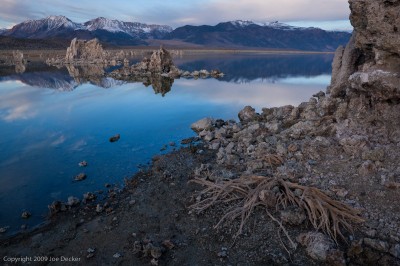The Tuesday Composition: Both Near and Far

If you like this article, you can now get the book! Joe has expanded the “Tuesday Composition” series into an inspiring new ebook on composition, especially for nature photography. Check it out: The Tuesday Composition.
One of the more common idioms in landscape of photography is the near-far composition, a powerful technique for creating depth and relationships within a photograph.
In a near-far composition, a small foreground element is emphasized and placed in a background that establishes context for that element. For example, the dead bush in Bleached Bush Skeleton, the bush remains are the subject of the photograph. The lake, the tufa in the lake and the Sierra Nevada all tell us something about the location the bush remains are in.
Put another way, if you were to try and write a sentence describing what a near-far photograph is about, it would usually be something like, “This foreground (thing) is in the background (environment).” The foreground object is the subject of the sentence, it is in general the more important of the two elements in a near-far image.
When I say that the foreground is emphasized, it’s important to be clear about how that’s done. For the foreground to be comparable in size to the background, it needs to be much closer to the lens than the background. While it might seem in theory that this could be accomplished with almost any sort of lens, the smaller depth-of-field of telephoto lenses often make it impossible to keep near and far objects both in focus. As a result, the most dramatic near-far compositions are usually made with wide-angle lenses. Hyperfocal focusing is often used to create the greatest depth-of-field. (more…)